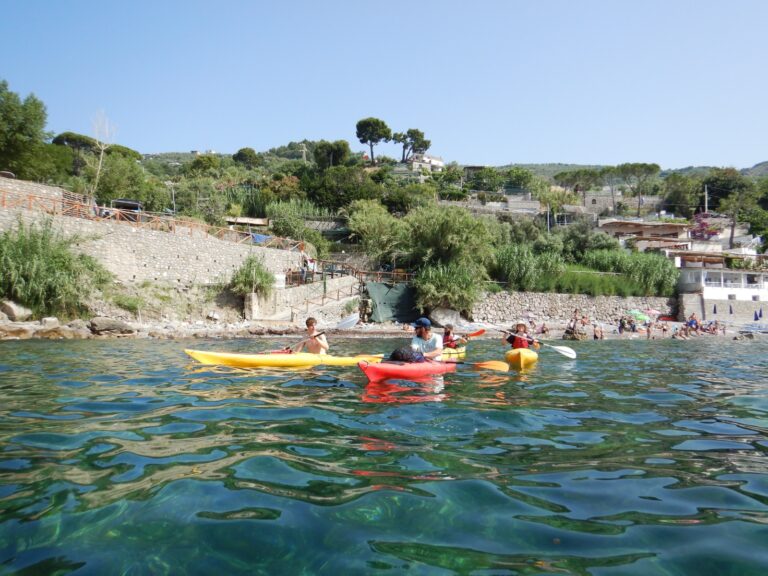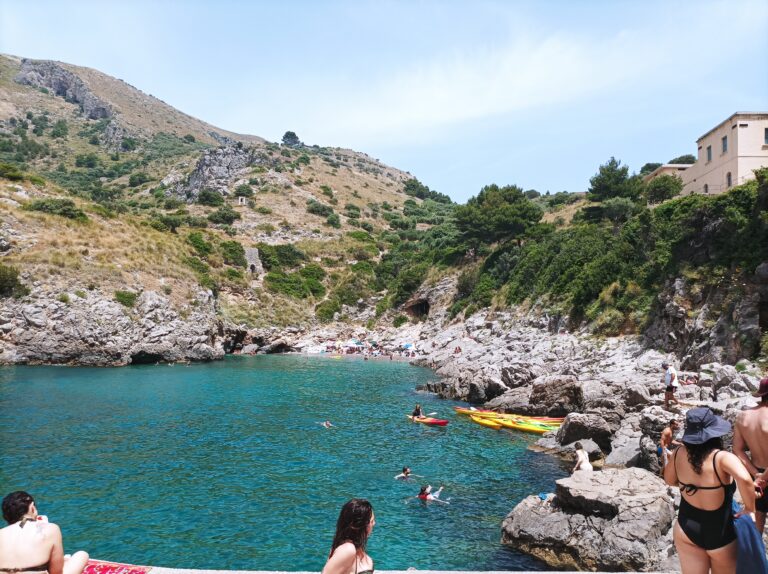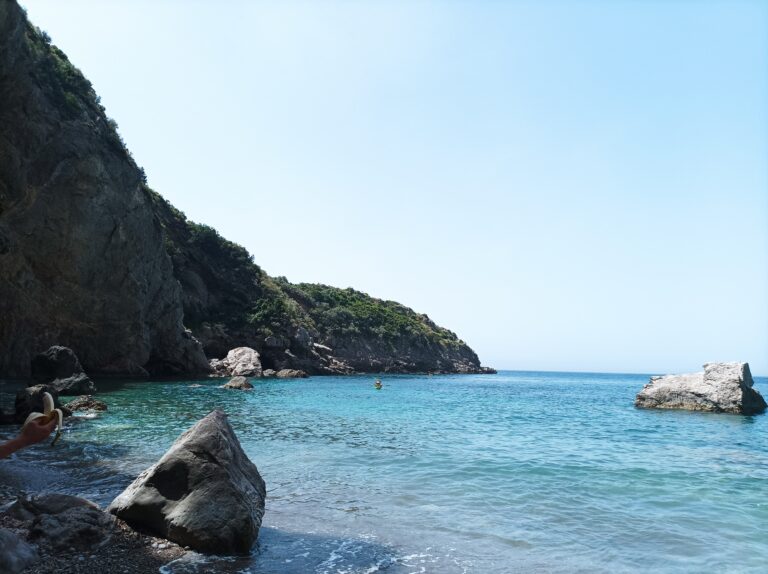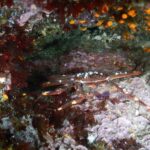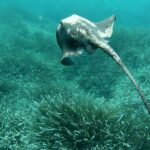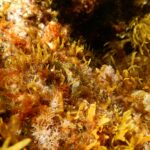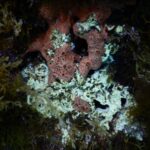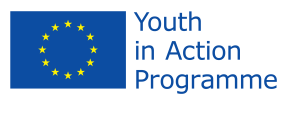Updated on December 15, 2022
Sentinels of Stone of the Marine Park
Here is a little cultural article about the watching towers in the peninsula, based on the conference “Le Sentinelle di pietra – le Torri di Guardia e di Difesa della Costiera di Amalfi e di Sorrento”, organised by the Massa Lubrense Archeoclub on the 30th of September 2022. There were the interventions of Stefano Ruocco (president of the Archeoclub), Salvatore Ferraro (academic), Giovanni Visetti (cartographer) and Don Mario (hosting the event). This event has been the occasion to learn more about the rich heritage and history of the place, with its emblematic buildings that are the towers, spread on the Amalfi and Sorrento coasts. It also has been the occasion to pay tribute to the author of the book the most well documented about this subject¹: Romolo Ercolino, historian from Positano, adoptive Massese who made discover the local history to youngsters of Massa, to diffuse his knowledge, not only through his various books.
In this article, what I would like to put into focus is the story and the existence of the towers on the park coasts. Among the 46 studied in the book (from Castellammare to Vietri sul mare), the towers we are talking about are 13.
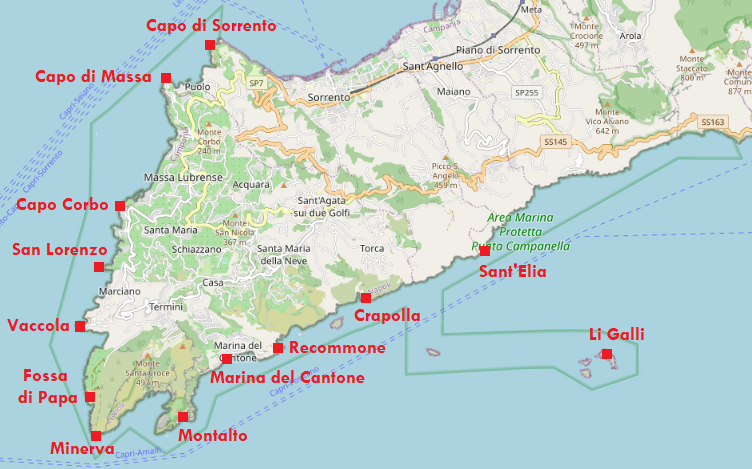
History of the watching towers
For a start, let’s present a little of the context of the towers creation. The building of these towers started in the Middle Age with the goal of alerting and defending the coasts from the Saracens (coming from modern-day Algeria, Tunisia), Turks or Barbarossa squads. When a threat was identified, the guards of the first tower to see it were lighting up a fire during the day, as well as during the night, to report the emergency situation with smoke (during the day) and with flame (at night). This signal was transmitted from one tower to another with the surveillance of the guards who saw the signal on one of the surrounding towers, then repeated the signal to transmit it to the next tower. This allowed to form a chain of information and to warn the populations.
Regarding the towers typology, then have been built and modified during various periods, from the Middle Age onwards, following the change of regimes in the region:
- the round towers, so called “Angevin”, date back from the 1200′-1400′
- the square towers, so called “Aragonese”, date back from the 1500′
- the towers with ulterior modifications made during the Bourbon period, in the 1700′-1800′
According to Salvatore Ferraro, the towers did not reach their goal because they did not achieve to defend the (grain) trade and neither protect from the robberies. In fact, on the 13th of June 1558, the sack of Sorrento during San’Atonino day happened. It has been told that the population was sleeping, with the popular version as “a good excuse of the traitor who opened the doors” according to Ferraro, the chronicles mentioning the fact of a sleeping city. The entire peninsula has been impacted, as despite the existence of the towers, a great part of its inhabitants fled up to Monte Faito.
That is why, the inhabitants settled in high altitude on the Amalfi coast, in order to be able to escape and defend themselves better.
It is also important to know that the defence of the Southern coasts was devolved to the cities from the Spanish central power, during the Aragonese era, for example. Indeed, every tower was armed and defended by the inhabitants close to it.
Then, the towers have been curated until the fall of the Bourbon and the Unity of Italy. During the Bourbon era, public entities, communes were curating the towers. The communes were deemed to not conserve them well, as it has been the case in Punta Campanella, given that the maintenance of the towers was very costly for them.
Regarding the influence of the towers in art, many travellers, painters, artists based in the region, have been inspired by it through the centuries, such as the principal dancer Nureyev who created his artistic shelter in the tower of Li Galli.
Moreover, among the long history of the towers, some Jews have been hiding in the towers during World War II. There is a local story telling about an autochthonous man with a whistle who was signalling the arrival of prefectural controls so they could escape.
The Towers of Punta Campanella MPA from Capo Germano to Capo di Sorrento:
- Li Galli: very important tower to make a connection between the steep coast where there was no tower and the others towers around.
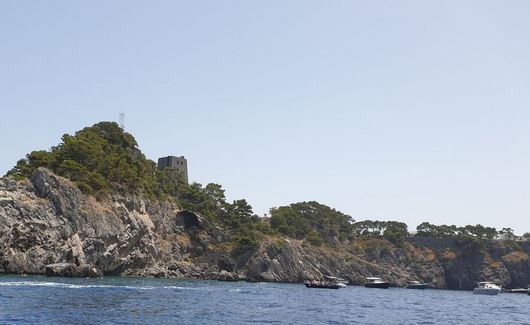
- Sant’Elia
- Crapolla (or di San Pietro ad Capona)
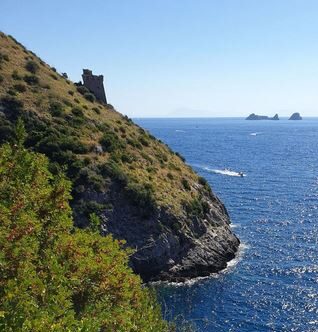
- Recommone
- Marina del Cantone
- Montalto (or della Mortella)
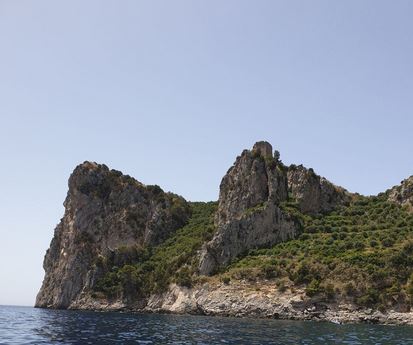
- Minerva (Punta Campanella): its first version is built in the 13th century, and its following shape is in the 16th. Before the tower, there was an Antic temple dedicated to the goddess Minerva.
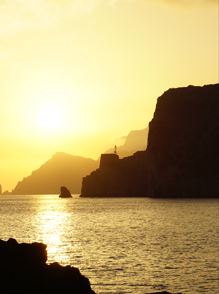
- Fossa di Papa
- Vaccola (Punta Baccoli)
- San Lorenzo
- Capo Corbo (Capo Corvo)
- Capo di Massa (or di Vilazzano)
- Capo di Sorrento: no longer existing tower.
To conclude, as Ferraro pinpoints it, there is a need to make these towers an open-air museum because it consists in a significant work. Don Mario during the conference added that it is fundamental to make youngsters and young people in general understand the richness of the culture and the importance of its conservation.
Massa territory is so rich of cultural and historical heritage; it is needed to raise awareness about this heritage but also to conserve it.
¹ In order to know more, I recommend the reading of ERCOLINO, Romolo, Sentinelle di pietra – le Torri di Guardia e di Difesa della Costiera di Amalfi e di Sorrento, Nicola Longobardi Editore, Castellammare di Stabia, 2022 [untranslated].
— Paul Descoeur
Updated on December 8, 2022
Ieranto’s State of Mind : a personal story
All of the people that have passed through this project, more or less, will share similar thoughts, memories and moments from Ieranto. It is a place that pulls everyone in, including our group and me of course, and for that I really wanted to share my own experience and summer memories. I think it could be quite entertaining, not only for people wanting to participate in this project, but also for people just wondering what we are all doing every day in these kayaks, during all summer under the heat, and why exactly we enjoy it so much.
I think it all started when we saw Ieranto for the first time. We were not all together yet, but it gave to the ones that were there an idea of what was about to follow. It was a beautiful spring day (sunny and fresh) and we were taking a hike towards San Constanzo, the church that is right above Ieranto, one of the highest points in the area. And then we saw it. It was there, right below us, with its wings spread open, the falcon of the bay. The name Ieranto has Greek roots: it can come up either from the word ιέραξ, which means falcon, or from the word ιερό, which means holy. That moment, on the path, I could understand perfectly that both of these etymologies could be equally true. Looking at Ieranto from there you can see the shape of a falcon traveling around, and also the beauty of this place, which makes it kind of sacred ground.
Finally, after weeks of delay, we managed to start our activities in the bay in mid of June. This time the team was almost complete (only Olivier was missing). We all met in the square of Nerano, the small village that is exactly before the path that takes us to Ieranto. We sat around the map of the area and exchanged some basic information about where we were and what we were about to see. The adrenaline started to kick in. We were about to meet the place we would spend the rest of the summer in! I remember looking at the faces of everyone: some were nervous, others excited like me and others lost in daydreaming thoughts.
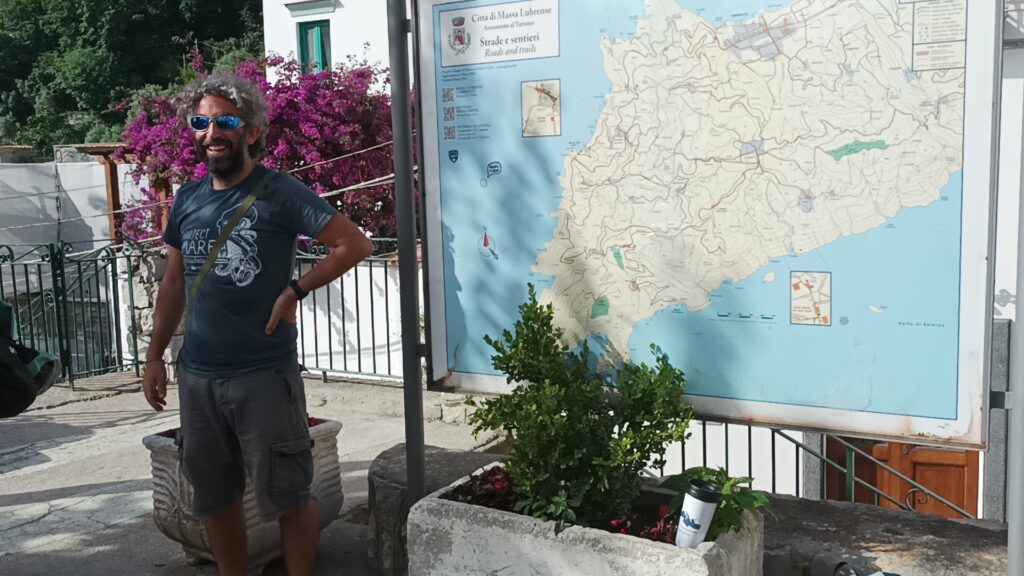
We would go to Ieranto in teams: some by land and others by sea with kayaks from Marina del Cantone. I was on the kayak team! When we managed to take all the needed equipment out (paddles, safe jackets, kayaks, wet bags for our stuff) and get ready (swimming suit, hat, sunglasses, shirt and water), the instructions by Mimì (our coordinator) started. How do we sit on kayaks, how do we hold the paddles, how do we navigate it in the sea? Info, info, info. It is interesting how all of this information that was thrown at us at that moment, without realizing, became imprinted on our brains later through experience. We did the most beautiful first kayak trip anyone could wish for. Paddling in the sea, visiting caves, cleaning a bit here and there, avoiding waves and maybe getting a bit sore. Our muscles were not trained yet to endure the 40 minutes trip to Ieranto, but this did not make the experience at all less exciting than it was.
Getting into the bay, I remember the wind blowing in my face and the water around me leading me towards the platform. I remember making a proper “wow” face, and the adrenaline kicking in for the second time that day. Observing the small beach, the stairs leading up to the buildings that used to be part of the quarry complex that used to be in Ieranto for years, the stone-made platform, the bigger beach with caves in both sides of it, the cliffs surrounding all the bay swallowing you in-keeping you grounded, the nature around me…The most beautiful part of it all was that we arrived by sea first. We took all of the beauty in, watching what we saw before from up-down, from exactly the opposite side, down-up. Looking back now, it is a very weird feeling when you see or feel a place for the first time. It is always unique and pure, a clean slate. No memories surrounding it, no recalling of previous times, no idea of how it actually is. There is nothing to spoil it. Try to picture your first time walking/driving/cycling on a street, that later you start using multiple times…Everything is alive, colorful, thrilling and sonorous. Your curiosity takes all the details in, without maybe processing them. They are just stimuli for your brain to linger on and process, when you finally understand how a place works. Usually this magic is getting lost as you get used to it, but thankfully this is not the case for Ieranto.
We explored all the caves, we went to the big beach, we swam, we dived from the platform, we snorkeled, we breathed it all in…We talked about our responsibilities there and how it was going to be during summer. All of us listening, but none of us exactly understanding. Describing reality in Ieranto is not an easy thing to do. The day served as a first training for us, a training for all the activities that were about to begin, plus as a first meeting with our “home” for the rest of the summer.
The route to Ieranto from land is equally thrilling. There is a hiking path from Nerano leading to the bay 30 minutes long. It can be challenging in certain spots, especially while coming up, but give it some time and I promise that you will learn to enjoy it. The path is surrounded by nature and the constant presence of sea on the horizon. Beautiful panoramas here and there and after a point you have Capri in front of you. It is as if you can touch it, so close it seems to be. When you reach that point you know that you are either arriving at the bay, or if you are returning back, that the steep part is about to finish. Also you know that it is time for the coffee of Salvatore, the most delicious coffee you will ever taste, with the perfect view and the best company. I was always appreciative of these moments and I think so were the others. They are moments of calmness and rest, during a period that you will not have a lot of those.
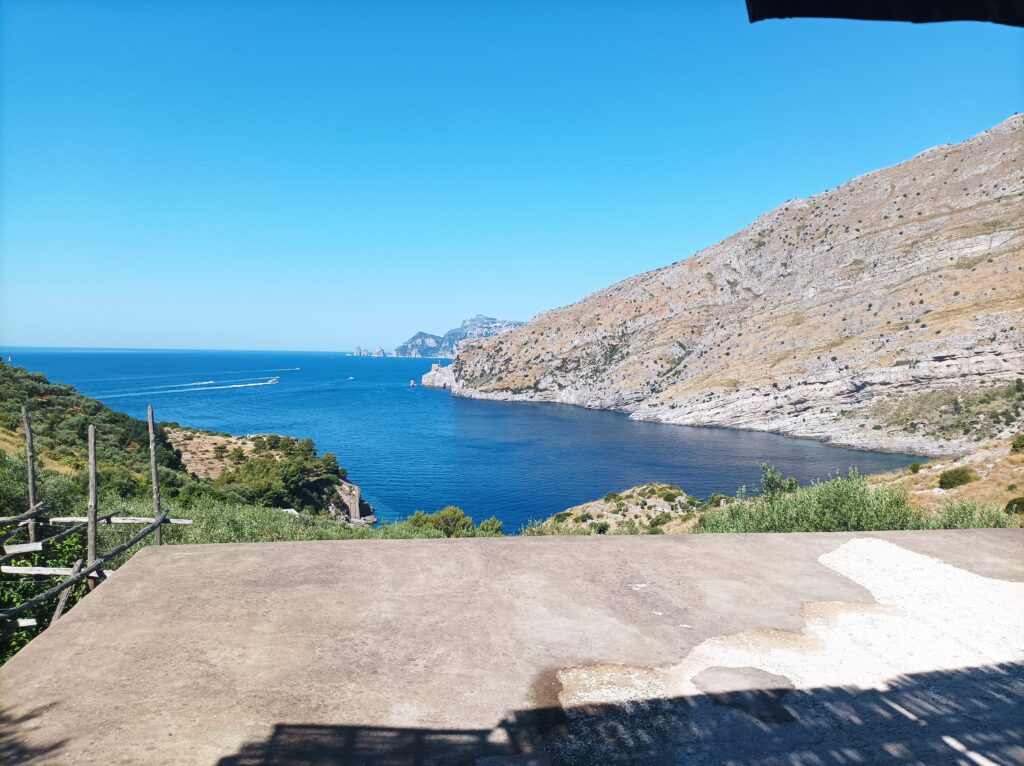
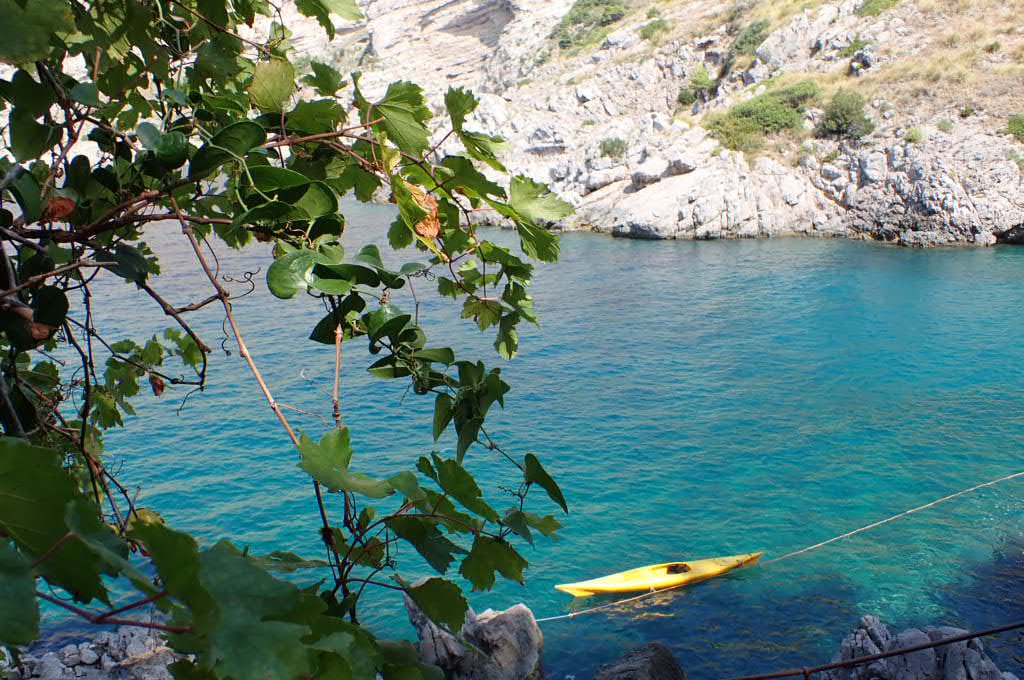
Our activities in Ieranto were mainly the same every day, while having of course some surprises on the way. What we do usually after arriving is: taking out the needed kayaks, waterproof tables for keeping data, setting an info point in which we work together with FAI (who owns and manages Ieranto bay –on the land– all year long), preparing for possible excursions during the day and organizing our turns for both monitoring by land and sea. This kind of routine had been established early on and every time depending on the pair that was working, we were adjusting the turns accordingly.
Since Ieranto belongs to Zone B of the Marine Protected Area of Punta Campanella, it is necessary to prevent unauthorized motor boats from entering and mainly anchoring in its waters. That is the part of sea monitoring with the kayaks. Ieranto is characterized by the presence of Posidonia oceanica meadows, a very important seagrass for the Mediterranean basin, providing oxygen and enhancing biodiversity in the sea. The process of approaching the boats is always an experience. All of us had their own way of explaining to them why they can’t stay here or asking for some basic info from them, which makes it quite interesting. You understand the different personalities of everyone and ways of interactions. Of course there were cases of us paddling after boats, in our small yellow kayaks, while waving and making signs to prevent them from the worst: setting the anchor and destroying the meadows. Not all the people on the unauthorized boats were accepting of the fact that they cannot stay on the bay, but many of them were interested in what we were saying and understanding of how important it is for Ieranto to be preserved and protected. There were also authorized boats entering, using the boas to remain for a bit on the bay and enjoy its magnificence. These boats were filled with familiar faces, accompanied with groups of tourists. After a point we learnt to recognise the permitted boats by afar and we all had our favorite ones, the ones we preferred more to interact with. Even with them we had to keep data to be sure we are aware of their use of the bay.
The next part of the activities were the excursions. Groups of tourists that were visiting Ieranto, wanting to get to know it better. They could do a guided tour with kayaks or a guided snorkel dive, or both of them. Some groups were bigger than others, some more motivated, some more interested, but all sharing the excitement of exploring Ieranto. After a point we also got the chance to do some guided tours and provide all the information we had gathered during our experience there. To speak about the history of the bay, the species of animals that characterize parts of it, the natural elements that define it and to share the love we have for this place with them. There were days that required the whole team to show up, since we had large groups of people visiting due to special events. Every day were usually just 2-3 volunteers, with one responsible (Gianna or Alba), and the employees of FAI. Those days we could be at least 10 of us working at the same time, making the situation quite stressful and chaotic. Especially the first weeks that we did not have much experience with large groups, brought to the surface some organizing issues we had. By the end though it was amazing how we had managed to evolve, how everything worked as a well-oiled machine, how everyone knew exactly what had to be done, how everyone helped with everything without even realizing, how we were adapting simultaneously when something didn’t go according to the plan.
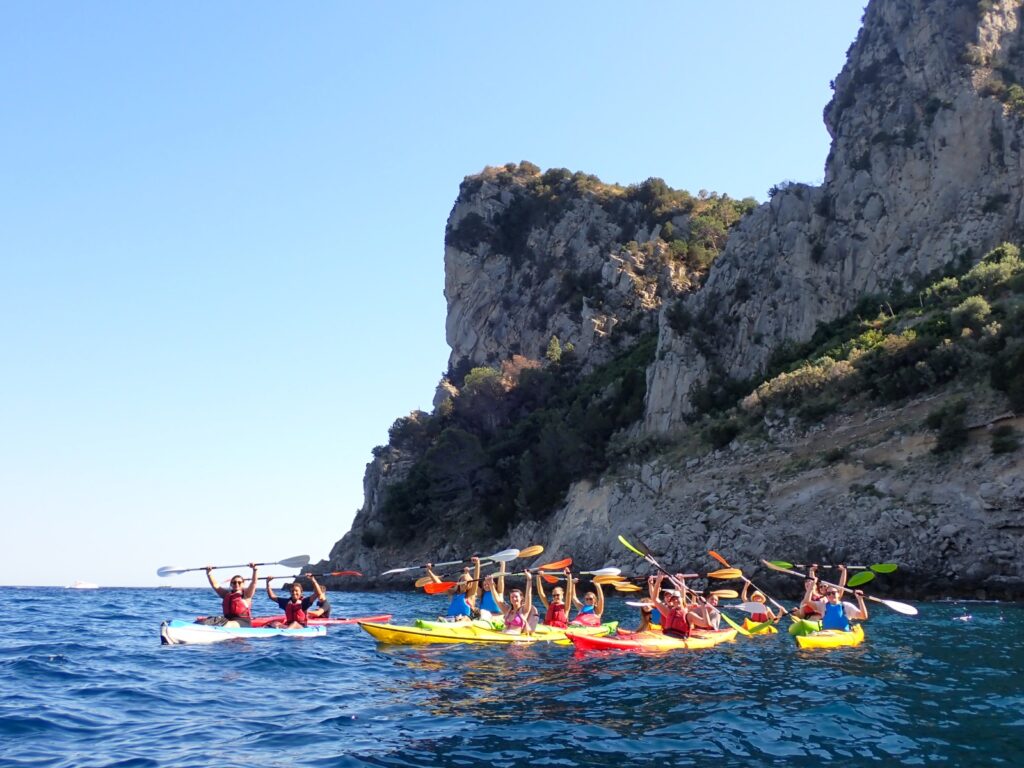
We were surrounded constantly by all the people from FAI, who were there to assist us and provide info along with us to all the people entering the bay, making them aware of the beauty and the history of the place that they were about to see, as well as raising awareness about its need to be protected and respected. I have so many beautiful memories of discussions with visitors either by land or by the sea. It was also heart-warming finding people to share the appreciation we have for this place and respect the work that we were doing. All of us I think recall funny moments with eager visitors.
And then it’s the part of going home after a long long day in the sea. You get those two feet that carried you down, to carry you up. With heat and tiredness that sometimes you mind, but mostly you don’t. Because there is the coffee stop as I already mentioned, and then you reach Nerano where you get to relax and enjoy a bit of the life of the place, either while playing football with the kids or having a small aperitivo. You get to laugh and talk about the nice moments of the day, and thank your body for making all the effort. What follows is going home to “the family” of volunteers, sharing a meal, enjoying the summer night and catching up. By the end of summer you get to have so many similar but unique days at the same time and you get to wonder how was it possible for me to endure a summer like this so easily. I still have this question for me. I never expected how strong my body got to be and my will as well. It’s so interesting to see the mental and physical evolution we all had during these months.
Even in November when we went for some last things that had to be done, Ieranto hadn’t lost its character. I got to swim in its waters one last time, along with a seabird which was fishing some meters away from me. Because that’s what you get when you are there: one balance between people and nature. We have seen rays, barracuda schools, sea stars bigger than our palms, and so much more that you usually forget how impressive they can be. Nature is part of us and Ieranto keeps reminding us this.
I think that the most beautiful part of Ieranto is hidden in two different spots. I wish I knew if others share the same opinion as me, but in reality this is the most subjective part of this entry. The first part is the connection that it has managed to create between so many different people and this is something that has happened mainly because of Project M.A.R.E. Brining volunteers to work every year creates a chain of people who love a very specific place. But it’s not only the volunteers and the people managing the Project that belong to this chain. It is the locals, it is the people from FAI who supported us constantly, it is the visitors, it is every group that came by for a guided tour, and it is everyone that we spoke to in these boats. This chain is what makes Ieranto so special. It is a place where you sense the positive and loving energy of a community.
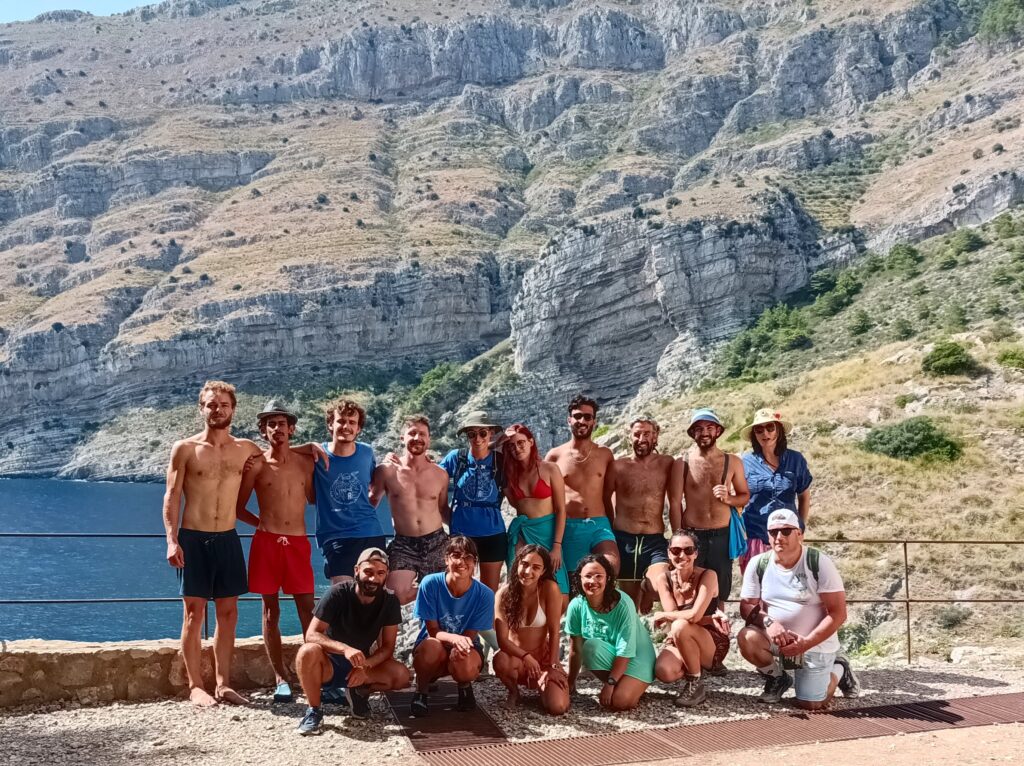
The second part that for me was defining my feelings for Ieranto is the experience of being alone in a kayak in the middle of the sea. I do not know if I can still explain it to people. It is a feeling of humbleness. You are there, surrounded by blue, by rocks that change shape every hour of the day, by nature. You live in the now. There is nothing before or after that moment, because at that moment you are just there. Waiting for a boat, doing a dive to refresh yourself, making a small tour with your kayak here and there. But you are always there. It is you, your thoughts and the paddle. You can either accept it and enjoy it or bear it. I chose to do the first and I recommend it to any future volunteers as well.
If you ever visit Ieranto, always remember that we were also there. That every spot has a shared history and that your memories of the place will stay there as well, making Ieranto even more precious. Because memories are treasured and valuable. Remember that we probably have a story to tell and reach out to ask all of the people loving Ieranto why they adore it that much. I am very sure you are going to realize that all these unspoken feelings are somehow similar between all of them.
Xenia Symeonidou
Updated on December 6, 2022
Posidonia flowering : an event full of hope
Posidonia oceanica is an endemic species from the Mediterranean Sea. This large and slow-growing seagrass develops on rocks and sandy bottoms in clean water from the surface to over 40-meter depth (Hemminga and Duarte 2000). Posidonia constitutes characteristic formations called “Posidonia meadows” or “Posidonia beds” which are very important habitats in the marine ecosystem. These extensive meadows provide habitat and nutrition for many species of fish, crustaceans, molluscs, bryozoans, as well as for many species of plants. The leaves of Posidonia reduce the speed of the current protecting the beach against erosion and the meadows also produce large quantities of oxygen through photosynthesis, helping in the absorption of CO2 emissions due to its high carbon fixation capacity. Due to its importance Posidonia meadows constitute a habitat protected by the European law (Priority Habitat in the Habitats Directive 92/43/EEC). Sadly, in recent decades Posidonia meadows are facing a regression, mainly due to trawling and anchoring, two activities that cause serious damage to the meadows.

Posidonia propagates mainly via vegetative reproduction through rhizome elongation and cuttings. However, Posidonia can also display sexual reproduction which increases genomic recombination, favouring adaptation and enhancing species resilience to environmental change. Therefore, we can say that Posidonia can also flower under the sea, this event occurs infrequently during autumn every five to ten years. The flowers are hermaphrodite, i.e. both male and females at the same time. The fruits require 6 to 9 months to ripen. Between May and July, they drop off, float for a while and end up washing up on beaches.
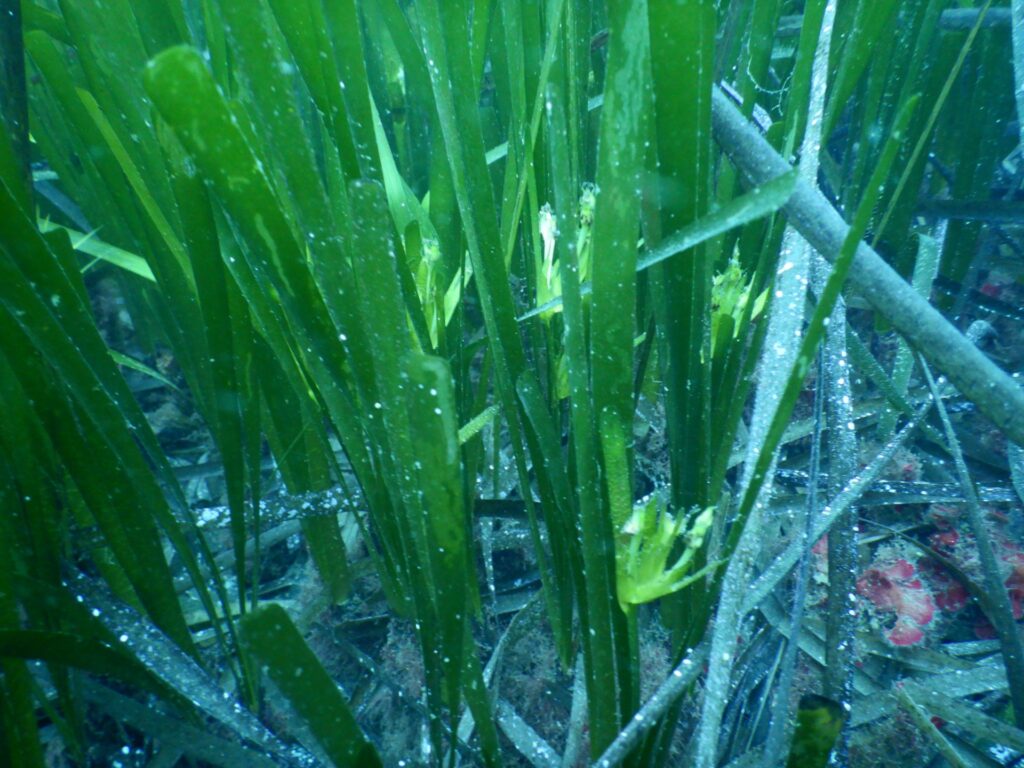
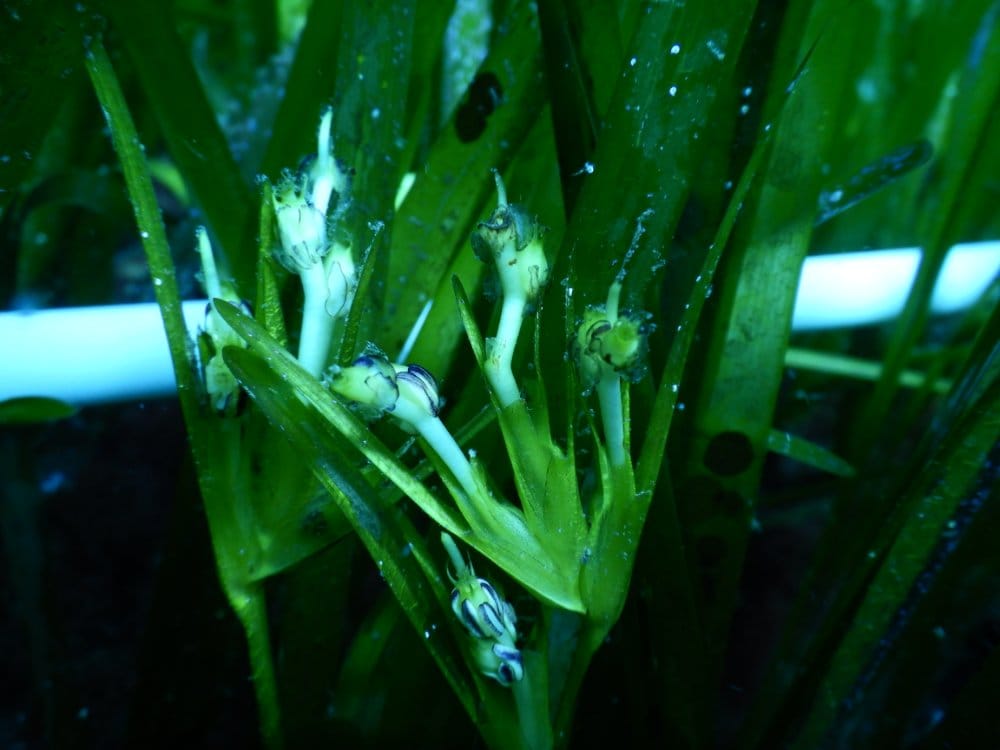
Last year, project M.A.R.E. participated in a survey to collect information and samples of Posidonia on behalf of the Italian Ministry of Ecological Transition. 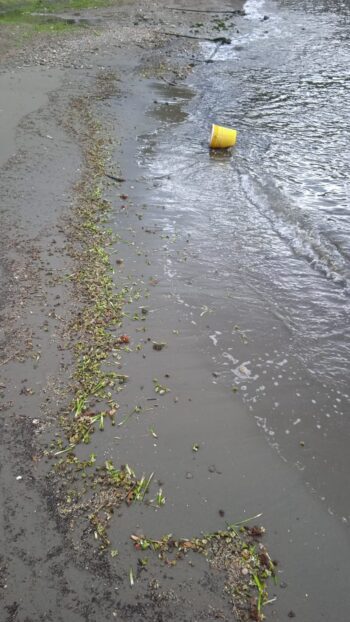 This survey was conducted in the Marine Protected Area Regno di Nettuno, which embraces the islands of Ischia, Procida and Vivara. While conducting this activity in late October and November we observed a big event of flowering that was happening not only in Regno di Nettuno but also in Punta Campanella, as we discovered later. The measurements we took in Regno di Nettuno indicated a high density of flowers as we found 10 to 30 flowers of Posidonia in quadrats of 40cm x 40cm. This abundance of flowers had as result a big production of seeds, that ended up washing up on beaches in great quantities, and this is what we will be observing next spring in the Sorrentine coast. We encourage you to open your eyes during your beach walks to observe this unusual phenomenon. Stranded in the beach you can found the Posidonia fruits so-called “sea olives”.
This survey was conducted in the Marine Protected Area Regno di Nettuno, which embraces the islands of Ischia, Procida and Vivara. While conducting this activity in late October and November we observed a big event of flowering that was happening not only in Regno di Nettuno but also in Punta Campanella, as we discovered later. The measurements we took in Regno di Nettuno indicated a high density of flowers as we found 10 to 30 flowers of Posidonia in quadrats of 40cm x 40cm. This abundance of flowers had as result a big production of seeds, that ended up washing up on beaches in great quantities, and this is what we will be observing next spring in the Sorrentine coast. We encourage you to open your eyes during your beach walks to observe this unusual phenomenon. Stranded in the beach you can found the Posidonia fruits so-called “sea olives”.
But why this happens? Studies of the seagrass Posidonia suggest that flowering is mainly related with high temperatures, and indeed, Ruiz et al. (2018) found in an experimental study that heat exposure can serve as primary trigger of flowering in Posidonia. Normally, very high temperatures stress Posidonia, inhibiting the growth. Therefore, for a sessile plant, seed production is the best escape strategy to overcome stressful conditions. Factors other than environmental temperature, including genetic, physiological, and age-related factors, may likely be involved in determining the flowering. Despite not all the factors affecting this phenomenon are well understood, Posidonia flowering seems to be a hopeful strategy in the global warming context. There is considerable room for optimism as it appears that our beloved seagrass can respond to increasing temperature in more plastic, more complex and potentially more resilient ways than previously imagined. Despite there is no scientific evidence published of this extraordinary event that happened last year, experts as Gabriele Procaccini from the Stazione Zoologica Anton Dohrn (Naples) confirmed that the abundance of flowers is something that has never seen in this area. If you are interested in knowing more about Posidonia and this extraordinary event, we encourage you to watch the seminar “Le Praterie sommerse del Mediterraneo” from the Stazione Zoologica Anton Dohrn.
Claudia Gaspar García
Bibliography
Hemminga, M. A., & Duarte, C. M. (2000). Seagrass ecology. Cambridge University Press.
https://www.cambridge.org/core/books/seagrass-ecology/53A7465F196885C57CF1977DF226C77D
https://books.google.it/books/about/Seagrass_Ecology.html?id=uet0dSgzhrsC&redir_esc=y
Luque, Á. A., & Templado, J. (2004). Praderas y bosques marinos de Andalucía. Junta de Andalucía, Sevilla.
https://uicnmed.org/bibliotecavirtualposidonia/wp-content/uploads/2014/12/Praderas-y-bosques-marinos-de-Andalucia_Praderas-marinasF_Intro-y-Posidonia-oceanica_Part1.pdf
Ruiz, J. M., Marín-Guirao, L., García-Muñoz, R., Ramos-Segura, A., Bernardeau-Esteller, J., Pérez, M., Sanmartí, N.,Ontoria, Y., Romero, J., Arthur, R., Alcoverro, T. & Procaccini, G. (2018). Experimental evidence of warming-induced flowering in the Mediterranean seagrass Posidonia oceanica. Marine pollution bulletin, 134, 49-54.
https://www.szn.it/images/pubblicazioni/97._Ruiz_et_al_2017.pdf
Procaccini, G. (2022, June 9). Le Praterie sommerse del Mediterraneo [Video file]. Stazione Zoologica Anton Dohrn, Napoli. Retrieved from
https://www.youtube.com/watch?v=KhEXIdFlnJQ
Updated on December 1, 2022
Deep immersion into the Crapolla Excavations
This year, from the 6th to the 20th of September, we got the opportunity to take part into an archaeological excavation campaign in Crapolla.
This excavation is coordinated since 2016 by the Federico II University of Naples (Humanities department) with the participation and help of the Archeoclub of Massa Lubrense.
The excavation is located above the Crapolla Fjord, behind the little church. In fact, San Pietro abbey, built during the 11th century, emerges with its remains behind the modern church San Pietro e San Paolo – built in 1949. The important event that made this abbey famous has been the stay between 1530 and 1533 of the two brothers and Benedictine monks Teofilo and Giambattista Folengo. Teofilo Folengo, also known as “Merlin Cocai”, great Macaronic poet, has described his life in the Sorrento peninsula through his work Varium Poema. His brother Giambattista, for his part, evocated the hermitage of Crapolla in the thirteenth book of his Polimones¹.
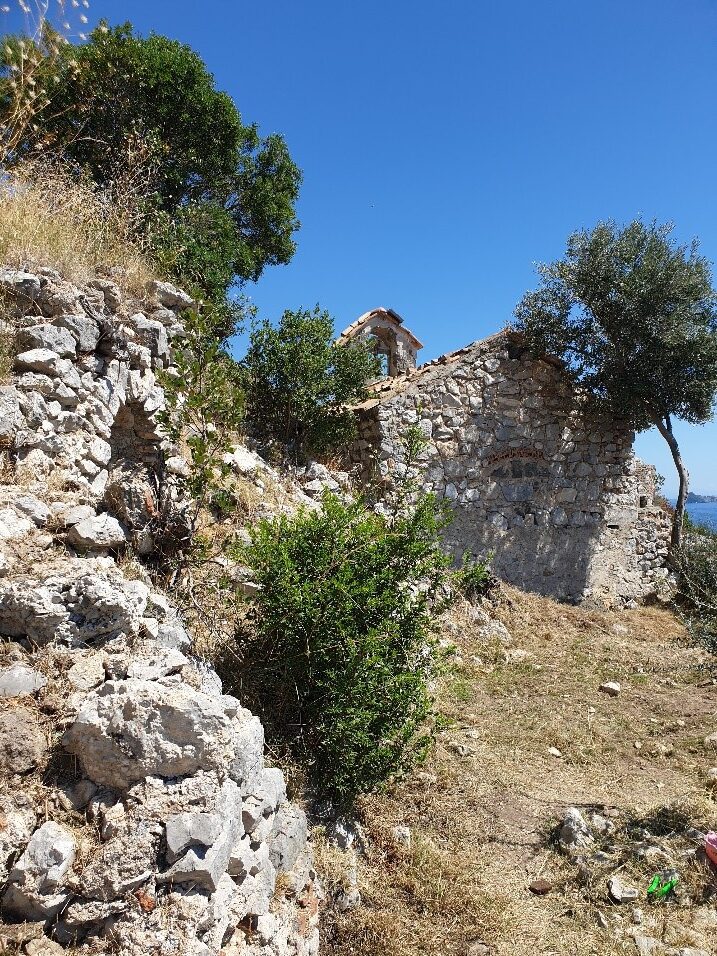
The goal of the various excavation campaigns through the study of the cloister area (claustrum) of the abbey is to understand what have been the various frequentation periods and moments of neglected state of the abbey and its surroundings.
Our help, as volunteers of Project M.A.R.E. has been to participate to the excavation activities, cleaning, inventorying but also to the preservation of the site, covering it again because at the end of the activities, the archaeological evidences have to be covered up in order to protect from deterioration the findings brought to light during the excavation campaign.
Concretely, regarding the two days in which I participated, we took off the soil and the canvas sheets that were covering the excavation site since last year. It has been a task of cleaning but also the opportunity to understand how is managed an excavation. With buckets, pointed trowels (fun fact: Italian people of the field frequently call them with the English word), brooms, shovels and pickaxes we started the rediscovery of the cloister remains, including some new investigated zones.
Then, the last day, we cleaned the excavation site carefully in order to allow taking pictures of the results of this year’s campaign. We also helped in achieving the inventory of the items found. Pedro also got the chance (and the meticulous glaze) to find a petrified shell filled with plaster – which probably served as decorative element on the walls of the cloister! At the end of the cleaning work, the team took pictures of the state of the excavation, on the ground as well as thanks to a drone! Then, finally, we covered again the site with soil, stones and canvas sheets to protect it until the next research campaign.
To sum up, this experience has been a beautiful immersion in the archaeological field alongside very nice students, postgraduates and PhD candidates, who have made us discover their world with kindness and passion!
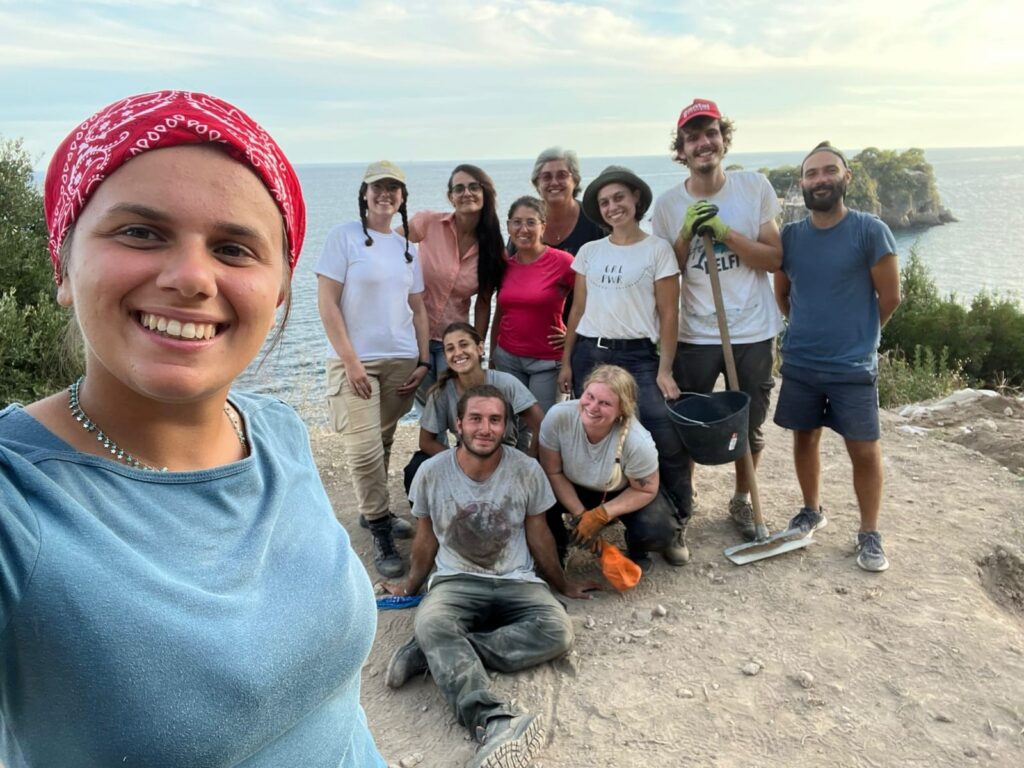
That is why, I would like to thank very much all the team of Federico II University of Naples: doctor Maria Teresa Cavallaro, Vittoria, Maria, Alessia, Giulia, Luciano and Raffaela but also doctor Elena Russo and professor Bianca Ferrara. Finally, I thank the Archeoclub of Massa Lubrense and Mimì to have given us the opportunity to take part in this unique adventure!
“Gli ‘archeolocos’ vi salutano!”
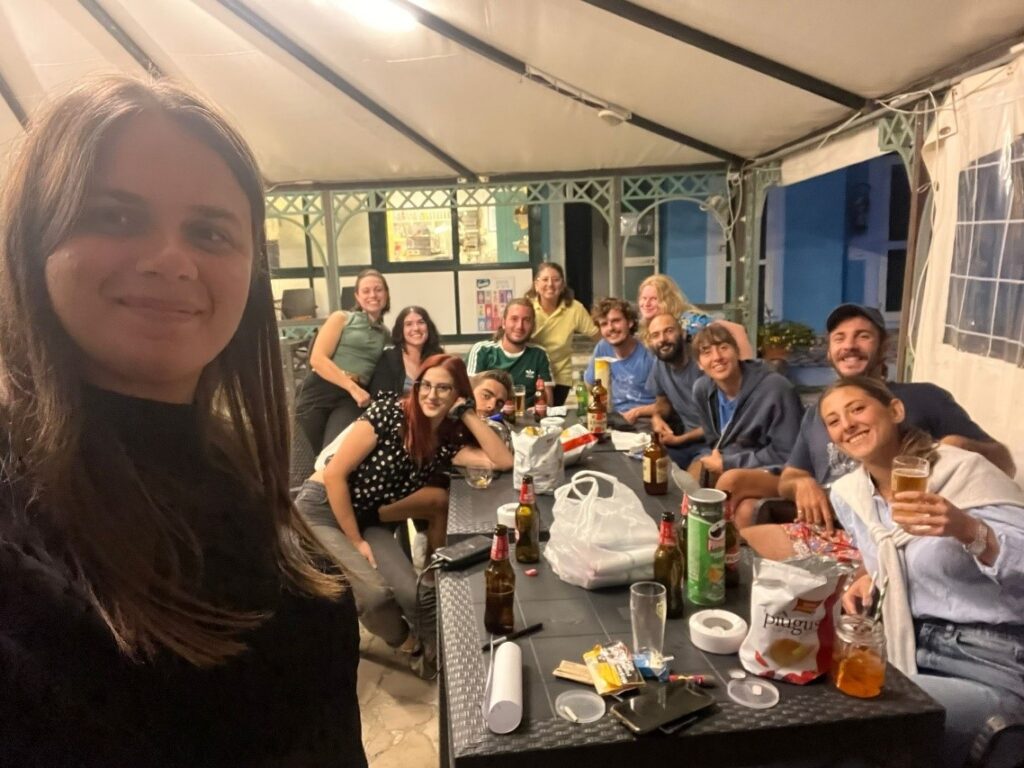
¹ To know more about the Folengo brothers, I recommend the reading of Giornate di Studio – I Folengo nella terra delle sirene, curated by Valerio TERRECUSO, Nicola Longobardi Editore (2020) [untranslated].
— Paul Descoeur
Updated on April 3, 2024
Looking for volunteers for the 11th edition of Project M.A.R.E.
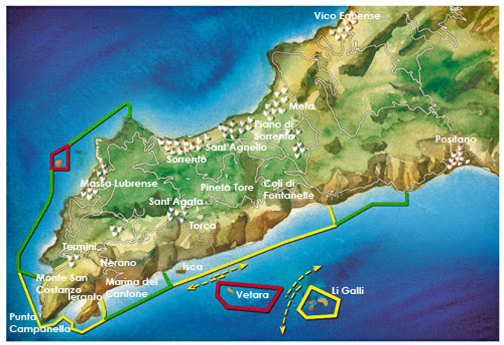
Thanks to a strategic partnership with the Italian National Agency, the Marine Protected Area (MPA) of Punta Campanella is offering the opportunity to 9 ocean enthusiasts from all over Europe and partner countries to take part in Project M.A.R.E. 2024, a mid-term European Solidarity Corps (ESC) which will take place from May 2024 to December 2024 and from May 2024 to October 2024 (*). Successful participants will find themselves inside the Project M.A.R.E. family, a community of close to 100 ex-volunteers and sympathizers from 15 different countries who all share a deep-found relationship with the sea.
Background Info
Project M.A.R.E. represents a unique volunteering experience in collaboration with the MPA of Punta Campanella to support marine conservation initiatives which aim to reduce human impacts on the marine natural resources within the region. Volunteers will work to spread awareness about the richness of marine ecosystems, to promote ecotourism, to stop anchoring and pollution, to clean up beaches and the sea, working side by side with operators of the MPA and many local organizations which work to achieve similar goals.
During the last eleven years of activities (from 2013 until today) volunteers have participated to many local initiatives, international meetings and conferences, and they have achieved many results in terms of support to the MPA and personal development. This life-changing experience provides a powerful way to make people understand the interactions between humans and ecological systems, helping them to understand the direction to take in their lives.
Site Info
Punta Campanella MPA is located around the Sorrento peninsula, between the Gulf of Naples, the island of Capri and the Amalfi coast and it contains one of the most biodiverse sites within this basin. This territory is made of “mountains that fall into the sea enchanted by the song of sirens”. Due to its location that is difficult to access by land, as well as its transparent water, the Sorrento peninsula became a preferred destination for luxury and mass tourism. In this context, the MPA aims to protect natural places, like Ieranto bay, which are high interest sites for the biodiversity as well as for their cultural and historical value. In those places can be found traces of ancient civilisation that makes them even more fascinating and mysterious.
The continuous human exploitation of coastal areas has led to a need for marine conservation and therefore the MPA was created. Due to the difficult access by land and the transparent waters, this area is the perfect place for boats and yachts to stop and anchor during holiday periods. This leads to a big threat for marine life, especially Posidonia oceanica meadows and hard substrate communities made of encrusting sponges and algae, the so-called coralligenous assemblages.
Since its foundation in 1997, the MPA is carrying out many summer initiatives to reduce the impact of mass tourism (between June and September) and to let people enjoy the Park in a sustainable way. Monitoring, ecotourism and conservation are the keywords to have a balanced usage of marine resources and volunteers play an important role in carrying out these operations.
The work of the MPA Punta Campanella doesn’t stop at the borders of the effective marine protected area, but goes far beyonds, wherever it is needed, through collaboration with several organizations and entities involved in marine conservation and education. For instance, since 2006, the park of Punta Campanella is actively working on a marine turtle conservation program in collaboration with the Antorn Dhorn Zoological Center, but also creating strong relashionship with fishermen and other actors of the sea. Thanks to these collaborations, the park of Punta Campanella started taking part in a summer program of sea turtle nest monitoring in 2020.
This year, the MPA of Punta Campanella is looking for volunteers to take part in two different projects !
1. Project MARE – MPA Punta Campanella
Who?
4 volunteers
Where ?
Massa Lubrense, 80061, Napoli (MPA Punta Campanella) (Hosted in Nerano)
When?
10th May – 30th November
Doing what ?
Supporting the MPA in a lot of different activities (monitoring of natural sites, guided visits, scientific studies, educational activities outdoor and indoor)
2. Project MARE – Conservation program in Cilento
Who?
5 volunteers
Where ?
Cilento‘s coast
When ?
20th May 2024 – 20th October 2024
Doing what ?
Supporting the effort of conservation and monitoring of marine turtle nests (early morning beach monitoring – you won’t see turtles, only traces -, nest hatching monitoring, preparation and implementation of educational activities).
Warning : The project of assistance to the turtle conservation program recquires for the volunteer to be resilient. It is occuring in an isolated place, and the third phase of the project is happening mainly on beaches, where the volunteers will have to do shifts to monitor the nests at all time during day and night. This is a highly demanding project, whether physically or psychologically.
Also, as both projects are managed by the MPA of Punta Campanella, the volunteers of both project will have the opportunity to do a temporary exchange in order to experience a bit of the other project.
Finally, due to the short period covered by the project, the MPA won’t be able to offer italian classes as intensives as it did the previous years. However, the work will recquire a high level of interaction with locals, and thus a capacity to understand and/or learn italian fast.
So, we ask all the candidates to specify their italian level, knowing that it will be an important (but non exclusive) criteria for us.
1. Project M.A.R.E. – MPA Punta Campanella – Position offered
We are looking for 4 volunteers, 2 boys and 2 girls that will commit themselves to the project for a duration of 7 months (May to December 2024 (**)) and that will work at different levels of organisation:
- The project team consisting of the group of volunteers from different nationalities and backgrounds, the coordinator and the mentor.
- Team of the MPA of Punta Campanella made of biologists, educators, mariners, divers, park guards.
- Local organisations (environmental organizations, diving centres, charter companies, other parks, etc.) that work to achieve the same goals.
Volunteers should be open-minded, curious and tolerant with a positive attitude and willingness to learn. We would like to host people with a particular interest and love for nature, the ocean, marine conservation, environmental education and outdoor activities to share this once-in-a-lifetime experience set in a multi-cultural context.
Duties and tasks
The MPA works on the activities that are listed below. According to the period of the year, volunteers will be involved in one or more of them. They will be expected to actively take part in these initiatives with a positive attitude using both the English and Italian language.
Marine Conservation – to mitigate human impacts on marine natural resources by reducing illegal activities and making people aware of the MPA and its goals.
Environmental Monitoring – to collect information about abiotic, biotic and human factors in the MPA and its surroundings.
Info & Awareness – to educate people about the park’s rules and threats to marine resources.
Outdoor Adventures – to meet nature face to face and enjoy its power and energy.
Beach and Sea Clean-ups – to try and mitigate one of the biggest human impacts on the marine environment: pollution.
Cultural Exchange – to learn about different cultures, tolerance and diversity.
Ecotourism Promotion – to spread info and open the doors to eco-compatible interactions between humans and nature.
Environmental Education – to participate in raising awareness of younger (or not) generation through educational activities
Schedule
Volunteers will support the park initiatives with a 30 to 40 hours/week commitment (6-8h/day). They will enjoy 2 weekly free days (not necessarily during weekend days). They will also enjoy 2 monthly free days to travel across this wonderful country or just to relax, which they can save up and choose themselves. The work will be done at the office and in the field (± 50/50 depending on the time of the year).
The schedule is more or less as follows (**):
Description | Timing | ||
TRAINING and ORIENTEERING |
| May – June | |
INTO THE BLUE |
| June-September | |
MATURATION |
| October-November | |
2. Project M.A.R.E. – Turtle Monitoring in Cilento – Position offered
We are looking for 5 volunteers, (2-3) boys and (2-3) girls that will commit themselves to the project for a duration of 5 months (June to October 2024 (**)) and that will work at different levels of organisation:
- The project team consisting of the group of volunteers from different nationalities and backgrounds, the coordinator and the mentor.
- Local organisations and volunteers that work to achieve the same goals.
Volunteers should be open-minded, curious and tolerant with a positive attitude and willingness to learn. We would like to host people with a particular interest and love for nature, the ocean, marine conservation, environmental education and outdoor activities to share this once-in-a-lifetime experience set in a multi-cultural context.
Duties and tasks
This project is taking place in Cilento, a region situated in the south part of the province of Campania, that became a very busy nesting place for the marine turtle Caretta Caretta. Since 2020, a big effort of conservation and communication have been put in motion in the region in order to protect this species and inform the local communities of its importance.
Concretely, the volunteering program will consist of :
1) First period (Mid May until early June) :
– Formation period
– Discovery of the territory
2) Second period (Early June – End July)
– Monitoring of the beaches do find turtle traces (Early morning, you wont see turtles, only traces)
– Creation of educationnal material that will be used in the third period.
3) Third period (Early august – October).
– Monitoring of the nest, assistance during the hatching of the turtles (All day, camping on the beach).
– Educational activities for the locals/tourists
– Information to the local/tourists.
For this project, the volunteers will be expected to actively take part in these initiatives with a positive attitude using both the English and Italian language.
Marine Conservation – to mitigate human impacts on marine natural resources.
Info & Awareness – to educate people about the life cycle of Caretta caretta, the threats endangering it and the work we do to protect it.
Outdoor Adventures – to meet nature face to face and enjoy its power and energy.
Beach and Sea Clean-ups – to try and mitigate one of the biggest human impacts on the marine environment: pollution.
Cultural Exchange – to learn about different cultures, tolerance and diversity.
Ecotourism Promotion – to spread info and open the doors to eco-compatible interactions between humans and nature.
Environmental Education – to participate in raising awareness of younger (or not) generation through educational activities
Schedule
Volunteers will support the park initiatives in Cilento with a 30 to 40 hours/week commitment (6-8h/day). They will enjoy 2 weekly free days (not necessarily during weekend days). They will also enjoy 2 monthly free days to travel across this wonderful country or just to relax, which they can save up and choose themselves. The work will be done at the office and in the field (± 30/70 depending on the time of the year).
The schedule is more or less as follows (**):
Description | Timing | ||
TRAINING and ORIENTEERING |
| May – June | |
FOLLOWING the TRACES |
| June-July | |
HATCHING MONITORING |
| August-October | |
What We Offer (for both project)
The project is a part of the ESC programme and is financed by the Italian National Agency. Thanks to these funds we can cover these expenses for volunteers:
Round trip – arrival and return to and from the Sorrento Peninsula at the beginning and end of the project;
Accommodation – shared accommodation and rooms with other volunteers;
Food Expenses – an amount of 150€ per month is guaranteed to each volunteer to cover food expenses (possibly in the form of coupons);
Pocket Money – an amount of 150€ per month is guaranteed to each volunteer for extra expenses;
Training – several training sessions, including weekly Italian classes, will be provided to volunteers in order to give them the best tools to support our work;
Orienteering – the first step of the project is to integrate in the local community, to orient yourselves in your new place and to understand the geography of the territory and the province of Naples in order to feel at home;
Mentoring – volunteers will take part in weekly meetings with the mentors and the coordinator to analyse and reflect on the training process, the progression of activities and the possible problems that might be faced during the project.
If this opportunity sounds interesting to you, do not hesitate and apply to join Project M.A.R.E. 2024!
(*) Dates are susceptible to change.
Check out our Instagram and blog to better understand who we are!
HOW TO APPLY: send a mail to mareapplication@gmail.com with :
- Curriculum Vitae
- Motivation video of 1 minute through WeTransfer in which you briefly explain who you are and why you believe to be the right person for Project M.A.R.E. 2024 (MPA or CILENTO).
- /!\ In the email, don’t forget to precise if you apply for the project 1 (MPA), the project 2 (Cilento) or both. /!\
Repeat : Finally, due to the short period covered by the project, the MPA won’t be able to offer italian classes as intensives as it did the previous years. However, the work will recquire a high level of interaction with locals, and thus a capacity to understand and/or learn italian fast.
Successful applicants will be invited for an interview in the third and fourth week of April.
So, we ask all the candidates to specify their italian level, knowing that it will be an important (but non exclusive) criteria for us.
DEADLINE: 14th of April 2024.
If you want further informations, contact us with your questions at mareapplication@gmail.com.


